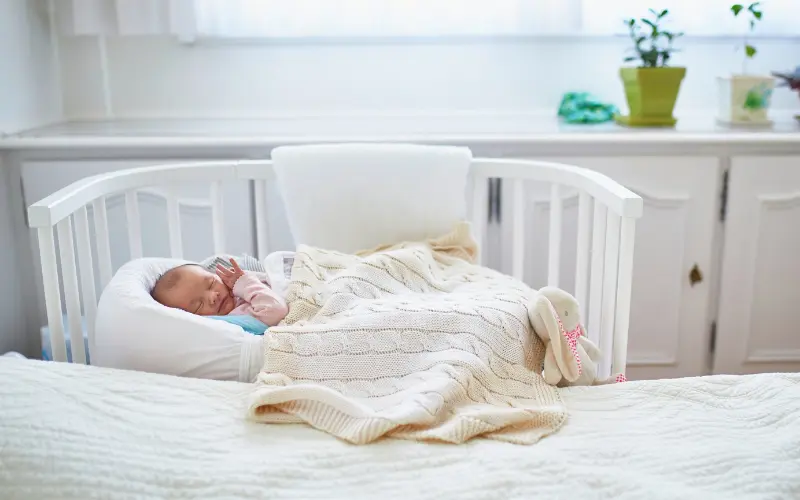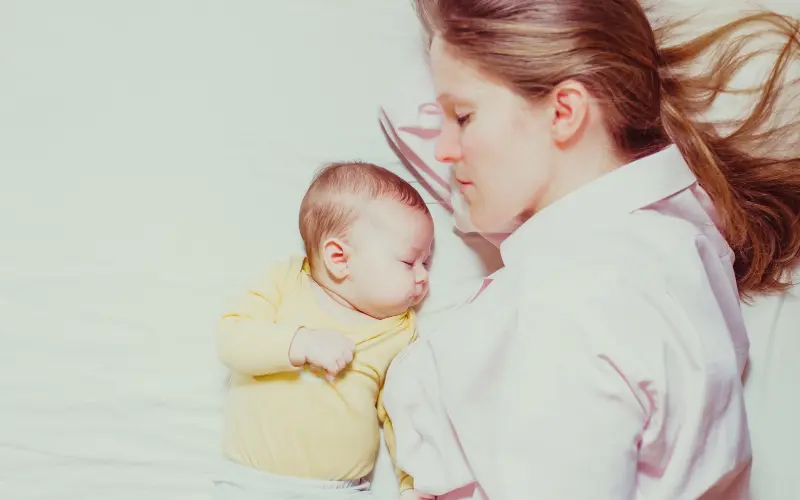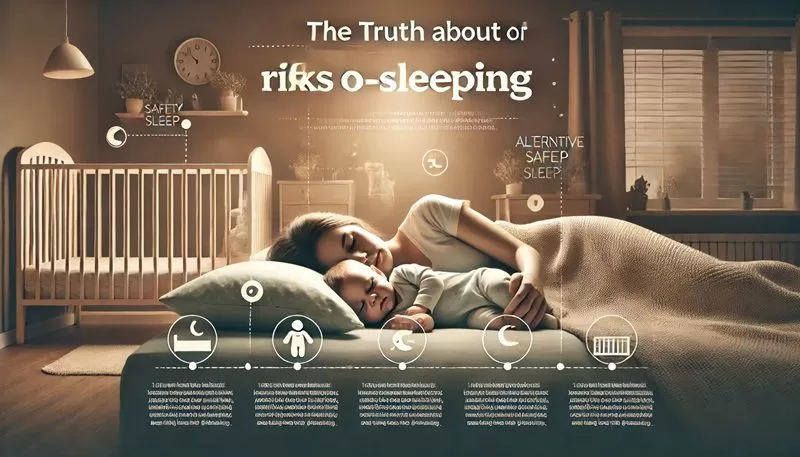Table of Contents
Risks of Co-Sleeping Truth
Co-sleeping is a common practice where parents share a bed with their infant. While many parents find co-sleeping beneficial for bonding and convenient for nighttime feedings, there are also potential risks involved. It’s essential to understand these risks and how to minimize them to ensure your baby’s safety. In this article, we will explore the truth about co-sleeping, providing valuable insights and safe co-sleeping tips that every parent should know. Additionally, we will highlight products from E Baby Mart that can help make co-sleeping safer and more comfortable for both you and your baby.
While many parents find co-sleeping to be a convenient way to bond with their baby, it’s important to be aware of the potential risks involved. According to the Centers for Disease Control and Prevention (CDC) on Sudden Infant Death Syndrome (SIDS), there are significant safety concerns when sharing a bed with infants. Parents should consider following safety guidelines to minimize risks and ensure their baby’s well-being.
Understanding the Risks of Co-Sleeping

Co-sleeping can be a bonding experience, but it’s important to be aware of the potential risks. Some of the most significant concerns involve the risk of suffocation, Sudden Infant Death Syndrome (SIDS), and accidental injuries. When parents, especially those who smoke, drink, or take certain medications, share a bed with their baby, the risks increase.
It’s crucial to be aware of these dangers and follow Co-Sleeping Safe Guidelines: What You Need to Know to reduce any potential harm. Having the right bedding and sleep environment can help make a difference. For instance, using products like our Breathable Baby Mattress ensures that your baby is sleeping on a surface designed to promote airflow and minimize suffocation risks.
Key Risk Factors of Co-Sleeping:
- Overheating: Babies are sensitive to heat, and sleeping in an adult bed with heavy blankets can lead to overheating.
- Suffocation Risks: Large pillows, blankets, or even a parent’s body could accidentally block a baby’s airways.
- Falls: Babies could roll off the bed if not properly secured.
Understanding these factors is crucial to practicing Safe Co-Sleeping: What Every Parent Should Know.
How to Practice Co-Sleeping Safely

Co-sleeping can be made safer by following specific precautions and using appropriate products. The safest way to co-sleep is by having your baby sleep in a separate, attached space designed for infants, like a bassinet or co-sleeper. This arrangement allows for proximity without the direct risks of bed-sharing.
Products like the Portable Baby Co-Sleeper available in our store are excellent solutions for families who want the benefits of co-sleeping while keeping their baby safe. The co-sleeper attaches securely to your bed, giving your baby a separate, safe space while still being within arm’s reach for feeding and comforting.
Co-Sleeping Safety Tips:
- Use a firm mattress: Avoid soft surfaces like couches or armchairs, which increase suffocation risks.
- Keep the sleep area clutter-free: Remove pillows, blankets, and stuffed animals from the baby’s sleeping area.
- Sleep on your back: Parents should sleep on their backs to prevent rolling onto the baby.
These tips, along with following Co-Sleeping and Why Every Parent Should Know How to Do It Safely, can make a significant difference in reducing co-sleeping risks.
Alternatives to Bed-Sharing

If bed-sharing still feels too risky, there are safe alternatives that offer the benefits of proximity without the associated dangers. A popular choice is the use of a co-sleeper bassinet, which can be attached to the parents’ bed but still provides a separate, protected space for the baby.
Our Adjustable Co-Sleeper Bassinet is a great product that offers this kind of safe sleeping environment. It allows the baby to be close to the parents without sharing the same sleep surface, reducing the risk of accidents while still supporting nighttime bonding and breastfeeding convenience.
Benefits of Using a Co-Sleeper:
- Keeps your baby close, making nighttime feedings easier.
- Reduces the risk of suffocation and falls.
- Provides a safe space specifically designed for infants.
This alternative option aligns perfectly with Safe Co-Sleeping: What Every Parent Should Know, offering peace of mind without sacrificing closeness.
Co-Sleeping Safe Guidelines: What You Need to Know

Let’s revisit the core guidelines for safe co-sleeping. Practicing safe co-sleeping requires adherence to these key tips:
- Always use a firm mattress.
- Avoid heavy blankets and pillows near your baby.
- Ensure your baby’s head is uncovered at all times.
- Don’t let your baby sleep between two adults, as this increases the risk of rolling over.
By following these guidelines, co-sleeping can be a safer experience, minimizing the risks while still allowing for bonding and nighttime ease. Using tools like the Breathable Baby Mattress from our store can further reduce risks by providing a safe, breathable surface for your baby to sleep on.
Co-Sleeping Myths and Facts

There are many myths surrounding co-sleeping that can confuse new parents. One common misconception is that co-sleeping always leads to unsafe situations, but this isn’t necessarily true if the proper precautions are taken.
Common Co-Sleeping Myths:
- Myth: Co-sleeping always increases the risk of SIDS.
- Fact: While bed-sharing can increase risks, practicing safe co-sleeping (e.g., using a co-sleeper bassinet) can significantly reduce the dangers.
- Myth: Co-sleeping creates dependence.
- Fact: Co-sleeping doesn’t necessarily create dependence in the long run. Many families find that co-sleeping provides comfort for both parents and babies during the early stages of life.
Understanding these myths and facts is important in making informed decisions about co-sleeping. By focusing on Co-Sleeping and Why Every Parent Should Know How to Do It Safely, you can create a sleep environment that works best for your family.
The Benefits of Safe Co-Sleeping

While risks exist, safe co-sleeping also offers numerous benefits. Co-sleeping helps facilitate bonding and makes breastfeeding at night easier. Many parents also find that co-sleeping helps everyone in the household get more sleep, as the baby feels comforted and secure being near the parents.
Key Benefits:
- Increased bonding: Co-sleeping promotes skin-to-skin contact, which can enhance the bond between parent and child.
- Better sleep: Many parents report that both they and their baby sleep better when co-sleeping.
- Breastfeeding convenience: Co-sleeping makes it easier to breastfeed during the night without having to get out of bed, leading to less disturbance and a more restful night for both the baby and the mother.
By following Co-Sleeping Safe Guidelines: What You Need to Know and using products like the Portable Baby Co-Sleeper, you can enjoy these benefits while minimizing the associated risks.
Conclusion
Co-sleeping is a deeply personal choice for every family, and understanding both the risks and benefits is essential for making an informed decision. By following Co-Sleeping Safe Guidelines: What You Need to Know, using the right products, and practicing safe habits, parents can enjoy the advantages of co-sleeping while ensuring their baby’s safety.
Whether you choose to use a co-sleeper bassinet, a breathable mattress, or a portable co-sleeper, products from our store can help create a safe and comforting environment for your baby. Ultimately, practicing Safe Co-Sleeping: What Every Parent Should Know will allow you to navigate the risks while enjoying the closeness and connection that co-sleeping offers.

